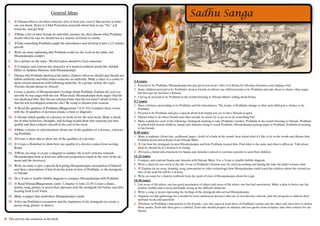
Poster_Sadhusanga.pdf
- 1. 1. C Discuss what to do when someone tries to hurt you, even if that person is some- one you know. Refer to Child Protection materials about how to say “No,” tell someone, and get help 2. CMake a list of what friends do and what enemies do, then discuss what Prahläda means when he says we should not see anyone as friend or enemy 3. CTake something Prahläda taught his schoolmates and develop it into a 2-5 minute speech. 4. Write an essay explaining why Prahläda could see the Lord in the pillar, but Hiraëyakaçipu couldn’t 5. Do a debate on the topic, ‘World leaders should be God conscious’. 6. C Compare and contrast the character of a modern political tyrant like Adolph Hitler or Saddam Hussein, with Hiraëyakaçipu 7. Discuss why Prahläda disobeyed his father. Explore when we should and should not follow authority and what makes someone an authority. Make a chart or a comic to show various situations with following authority. In a group, debate the topic, ‘Parents should always be obeyed’. 8. Create a picture of Hiraëyakaçipu’s feelings about Prahläda. Explain the real rea- son why he was angry with his son. What made Hiraëyakaçipu most angry- that his son disobeyed him; that his son criticized him; that his son wasn’t afraid of him; or that his son worshipped someone else? Be ready to discuss your reasons 9. C Read the qualities of Prahläda (Bhägavatam 7.4.31-33); Compare these verses with the 26 qualities of devotees (make a chart or diagram) 10. C Decide which quality of a devotee to work on for the next week; Make a check- list of what behaviors, thoughts, and feelings would show that someone has that quality and then evaluate oneself at the end of the week 11. CMake a poster or advertisement about one of the qualities of a devotee, referenc- ing Prahläda 12. CCreate a short skit to show one of the qualities of a devotee 13. C Create a flowchart to show how one quality of a devotee comes from serving Kåñëa 14. CWrite an essay or create a diagram to analyze the Lord’s violence towards Hiraëyakaçipu from at least two different perspectives (such as the view of the de- mons and the devotees) 15. Write an essay or give a speech first giving Hiraëyakaçipu’s description of himself, and then a description of him from the point of view of Prahläda, or the demigods, or Närada 16. Do a Venn or double-bubble diagram to compare Hiraëyakaçipu with Prahläda 17. C Read Çrémad-Bhägavatam, canto 7, chapter 4, texts 21-29; Create a dance, drama, song, picture or poem that expresses how the demigods felt before and after hearing from Lord Viñëu 18. Make a puppet that symbolizes Hiraëyakaçipu’s pride 19. CAct out Prahläda’s coronation and the happiness of the demigods (or create a poem, song, picture or dance) General Ideas 2-4 years: 1. Pretend to be Prahläda; Hiraëyakaçipu has just given you food—offer it to Kåñëa by offering obeisances and ringing a bell 2. Some children pretend to be Prahläda’s demon friends at school; one child pretends to be Prahläda and asks them to chant—they argue but then get up and have a kértana 3. Curl up & pretend to be Prahläda in the womb listening to Närada Muni’s telling about Kåñëa 5-7 years: 1. Have a kértana, pretending to be Prahläda and his schoolmates. The leader is Prahläda; change so that each child gets a chance to be Prahläda 2. Pretend to be Prahläda and give a speech about how happy you are to have Närada as guru 3. Discuss what to do when friends and other people we know try to get us to do something bad 4. Make sounds for each of the following: Demigods wanting to take Prahläda’s mother, Prahläda in the womb listening to Närada, Prahläda in school with demon children, Ñaëòa and Amarka trying to teach Prahläda, Hiraëyakaçipu getting angry at Prahläda, Prahläda preaching to his friends 8-10 years: 1. Make a sculpture (from clay, cardboard, paper, cloth) of a baby in the womb; hear about what it’s like to be in the womb and discuss how Prahläda heard about Kåñëa from Närada Muni 2. C List how the demigods treated Hiraëyakaçipu and how Prahläda treated him. Find what is the same and what is different. Talk about what we should do if a demon is in charge 3. CCreate a funny advertisement for Ñaëòa and Amarka’s school to convince parents to send their children 11-13 years: 1. Compare and contrast Ñaëòa and Amarka with Närada Muni. Use a Venn or double-bubble diagram 2. Write a diary for one week in the life of one of Prahläda’s friends once he starts preaching and during the time his father tortures him 3. C Explain (in an essay, drawing, song, powerpoint or other technology) how Hiraëyakaçipu could teach his relatives about the eternal na- ture of the soul but still be a demon 4. Write an essay for a history textbook from the point of view of Hiraëyakaçipu about his reign 14-18 years: 1. List areas of life where one has good association of others and areas of life where one has bad association. Make a plan to better use the positive facility and to keep spiritually strong in the difficult situations 2. Write a song or poem expressing the feelings of the demigods who served Hiraëyakaçipu 3. Organize weekly gatherings for a month for local adolescent devotees who are in non-devotee schools; plan the program to address their spiritual needs and questions 4. CDebate on Prahläda’s instructions to his friends—one side takes at least three of Prahläda’s points and the other side then tries to defeat those points. Each side then gives a rebuttal. Each side should prepare in advance and use quotes from scripture and other sources for au- thority C: This activity has resources in the book.